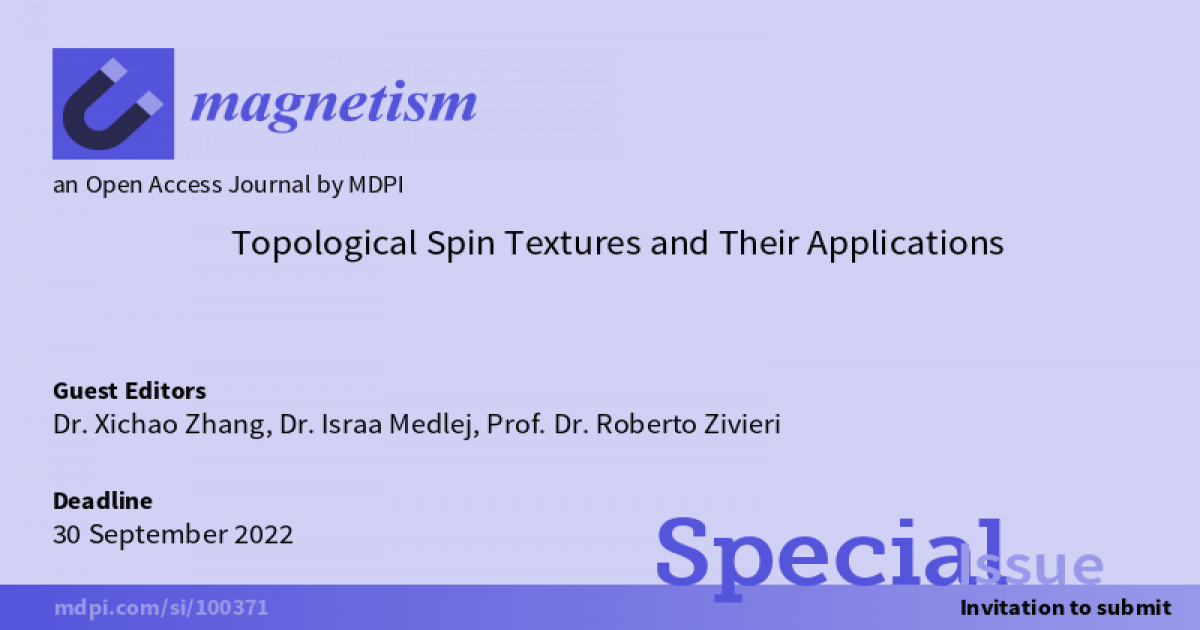Topological Spin Textures and Their Applications
A special issue of Magnetism (ISSN 2673-8724).
Deadline for manuscript submissions: closed (30 September 2022) | Viewed by 7345

Special Issue Editors
Interests: spintronics; micromagnetics; nanomagnetism; frustrated magnetism; frustrated spin systems; topological magnetism; topological spin textures; skyrmions; domain walls; vortices; magnetic memories; spintronic logic computing devices
Interests: artificial intelligence devices; quantum physics; solid state physics; condensed matter physics; spintronics; magnonics; ferroelectric and multiferroic materials; spintronics and magnonics based neuromorphic computing; unconventional computing; thin film magnetism; magnetic properties; THz; magnetic insulators; antiferromagnetic material; ferrimagnet; skyrmions; anti-skyrmions; antiferromagnetic skyrmions; vortices; domain walls; superconductivity and superconductors; neutron scattering; neutron diffraction; superconducting quantum design; vibrating sample magnetometer; micromagnetic simulations
Special Issues, Collections and Topics in MDPI journals
2. Istituto Nazionale di Alta Matematica (INdAM), 00185 Rome, Italy
Interests: solid state physics and lattice phonons dynamics; spin waves; ferromagnetic materials and nanostructures; low-dimensional magnetic systems; quantum magnetic models; magnonic crystals; magnetic metamaterials; magnetic signature of ships; quantum magnetic sensors; topological defects; magnetic vortices and antivortices; magnetic skyrmions; spin-transfer torque effect; spin-Hall effect; band structure and mobility calculation of topological semimetals and magnetoresistance; linear and nonlinear seismic metamaterials; statistical thermodynamics of biological systems; entropy of irreversible reactions in living systems; electrical power signals; distribution lines; smart grids
Special Issues, Collections and Topics in MDPI journals
Special Issue Information
Dear Colleagues,
Topological spin textures constitute an extremely hot topic since their first experimental observation in 2009. Typical topological spin textures include skyrmions in two-dimensional nanostructures and hopfions in three-dimensional nanostructures. In principle, all topological spin textures stabilized in magnetic materials can be used to carry information and thus are potential building blocks for future magnetic and spintronic applications. For example, both theoretical and experimental works have suggested that skyrmions can be used as key components in racetrack-type memory, logic computing gates, and neuromorphic computing. Recent theoretical works have also pointed out the possibility that skyrmions can be used as qubits for quantum computing. However, there are still many open questions in the field of topological spin textures. This Special Issue, Topological Spin Textures and Their Applications, will focus on both the fundamental research of two-/three-dimensional topological spin textures and the developments of practical applications based on topological spin textures.
Dr. Xichao Zhang
Dr. Israa Medlej
Prof. Dr. Roberto Zivieri
Guest Editors
Manuscript Submission Information
Manuscripts should be submitted online at www.mdpi.com by registering and logging in to this website. Once you are registered, click here to go to the submission form. Manuscripts can be submitted until the deadline. All submissions that pass pre-check are peer-reviewed. Accepted papers will be published continuously in the journal (as soon as accepted) and will be listed together on the special issue website. Research articles, review articles as well as short communications are invited. For planned papers, a title and short abstract (about 100 words) can be sent to the Editorial Office for announcement on this website.
Submitted manuscripts should not have been published previously, nor be under consideration for publication elsewhere (except conference proceedings papers). All manuscripts are thoroughly refereed through a single-blind peer-review process. A guide for authors and other relevant information for submission of manuscripts is available on the Instructions for Authors page. Magnetism is an international peer-reviewed open access quarterly journal published by MDPI.
Please visit the Instructions for Authors page before submitting a manuscript. The Article Processing Charge (APC) for publication in this open access journal is 1000 CHF (Swiss Francs). Submitted papers should be well formatted and use good English. Authors may use MDPI's English editing service prior to publication or during author revisions.
Keywords
- spintronics
- topological magnetism
- chiral magnetism
- topological spin textures
- chiral spin textures
- chiral domain walls
- chiral bubbles
- skyrmions
- skyrmioniums
- biskyrmions
- merons
- bimerons
- bimeroniums
- hopfions
- Dzyaloshinskii–Moriya interactions
- chiral interactions





